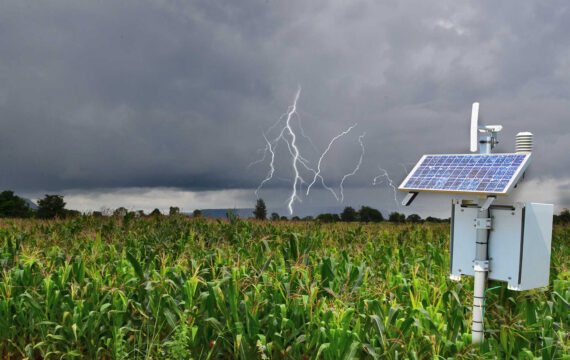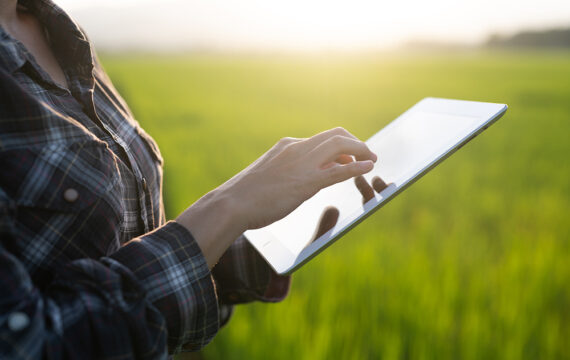For ages, farmers across the world have had to be resourceful when rain fails to come. To take matters into their own hands, they’ve used technologies like irrigation systems to overcome water deficits and maximize crop yields.
Irrigation systems, however, are inefficient. About half of all irrigation water is wasted due to runoff, wind, and evaporation. That’s because most irrigation systems rely on simple timers and controllers for scheduling. A much more efficient approach is to use water only when needed and apply exactly the right amount.
That, among other things, is what the Internet of Things helps farmers do. IoT makes farm management smarter by enabling farmers to improve efficiency through wise resource consumption.
In this article, you’ll learn about:
- The benefits of a smart irrigation system
- IoT ecosystem for smart irrigation
- Types of IoT sensors for smart irrigation of farmlands
- Extending the capabilities of a smart irrigation system
- Types of irrigation systems for farms
The benefits of a smart irrigation system
Growing at a CAGR of 15.3%, the smart irrigation market is expected to reach $2.1 billion by 2025 as agribusinesses and farmers actively embrace smart irrigation technology to improve their day-to-day operations.
The advantages of smart irrigation are far-reaching. By monitoring soil moisture levels, a smart water irrigation system allows farmers to automate their irrigation processes and reduce water use. In addition to more efficient consumption of resources, other benefits include:
- Cost savings due to minimized water waste
- Reduced human efforts
- A unified view of soil characteristics, including moisture and nutrient contents
- Smart notifications in case of abnormalities
- Better long-term landscape health
- IoT ecosystem for smart irrigation
To achieve these advantages, smart water irrigation systems make extensive use of IoT sensors. These sensors, placed in the field, send real-time data to a central gateway that then automatically switches on a water pump whenever moisture or temperature values are outside the predetermined range.
Wireless low-power networks like LoRa are used to empower IoT sensors and make it possible for information to flow in real time to and from the central gateway. The entire smart irrigation system can be managed by an end user through a custom cloud-based platform or mobile application.
Types of IoT sensors for smart irrigation of farmlands
Depending on the type of data to be captured, soil, weather, and plant IoT sensors can be used in a smart irrigation solution.

Soil sensors
Soil-based sensors gather relevant data about volumetric water content, salinity, electrical conductivity, and other crucial parameters. Located at key points across the field, these sensors send data to a smart water irrigation system to help farmers gain quick insights into the soil’s state and predict irrigation needs.
Weather sensors
Also called evapotranspiration (ET) sensors, weather sensors measure ultra-local environmental conditions like water evaporation from the soil surface and plant transpiration. Combined with data provided by a GIS-based solution, these sensors can help generate more accurate water predictions.
Plant sensors
Plant-mounted sensors are still new but show great promise in gauging a plant’s water status. Attached to a plant’s stalk or fruits, a sensor can track minute changes like swelling or shrinking and alert farmers to insufficient water content or yield-reducing tendencies in the field.
Extending the capabilities of a smart irrigation solution
An IoT-based irrigation system can be further enhanced with functionality that uses advanced software. You can customize your smart water irrigation solution and integrate third-party APIs to tap into additional valuable data and inform your decision-making on irrigation of farmlands.
Weather monitoring
One way to do that is to incorporate satellite data and weather reports from weather stations to better schedule your irrigation activities. Knowing that rain is forecasted, the system can wait and automatically recalculate the amount of required water based on actual precipitation received.
Location technology
Precision mapping also helps agribusinesses drive smart farming by optimizing costs and gaining deep insights. Reusable maps that bring together data from sensors and images from satellites and drones enable farmers to keep an eye on critical land characteristics.
Artificial intelligence
AI is becoming the bedrock of automation in farming. Apart from its use in novel but still rarely used agricultural robotics systems, AI helps to automate simple tasks like labelling data, building reports, and sending notifications. Such small steps to automation through AI are becoming easier to implement while their impact on agribusinesses is critical and can be seen in just a few months.
How technology reinforces each type of irrigation system
Based on how water is distributed throughout the field, you can choose from different types of irrigation systems that can be enhanced with smart irrigation software. The most common are flood, sprinkler, center pivot, drip, and micro-irrigation systems. Let’s see how technological solutions for smart irrigation can improve the efficiency of each type.
Sprinkler irrigation
In a sprinkler irrigation system, water is pumped through pipes and then distributed via high-pressure overhead sprinklers. These sprinklers can be set in a central location in the field or can be located on a moving platform.
Role of software: Thermal and acoustic rain sensors recognize rainfall and measure its intensity to schedule the next irrigation after rain stops. A smart irrigation system analyzes data and calculates the water budget for the next month. Sprinklers get automated notifications to prevent extensive water use and overwatering due to rain.
Center pivot irrigation
This is the most popular form of sprinkler irrigation and is also known as water-wheel and circle irrigation. A typical center pivot system consists of a long irrigating pipeline attached to a central tower and moves slowly over the field in a circular pattern, irrigating plants with sprayers.
Role of software: The system that controls circle irrigation sprinklers obtains data insights from in-field sensors to adjust the water stream or angle of flow. This helps to reach plants that are far from the water source and save those nearest from overwatering. By analyzing weather data and soil moisture, the system plans irrigation and calculates potential yield and harvest times.
Drip irrigation
In this type of irrigation, water is distributed directly to the roots of plants through pipes with small openings called drippers. This allows farmers to significantly reduce evaporation and runoff.
Role of software: For this type of irrigation, the main challenge is the visibility of the watering process. The system notifies the user through an app about starting and finishing irrigation. It also measures soil parameters before and after irrigation.
Micro-irrigation
Micro-irrigation is a low-pressure, low-volume system that offers precise control over watering. The system applies water directly to the plant’s roots, improving irrigation efficiency and ensuring uniform distribution.
Role of software: The system can plan the exact dosage for each plant as the amount of water is precisely controlled. AI algorithms can be applied to recognize plants and adjust watering appropriately.
No matter what type of irrigation system you choose, equipping it with powerful IoT sensors will help you gain data-driven, actionable insights and stay on top of your irrigation needs.
The bottom line
Agriculture is by far the largest consumer of water, accounting for about 70% of global freshwater withdrawals. What’s aggravating is that a huge percentage of this water is lost due to inefficient and outdated irrigation techniques.
Smart irrigation technology is set to fix these problems through the use of IoT-powered agricultural sensors that enable farmers to closely monitor field conditions and adjust irrigation practices accordingly. This results not only in more efficient water management but in higher crop yields and lower costs.
Looking to enhance your agricultural solution with IoT-enabled capabilities or build an indoor vertical farming system with AI? Drop us a line and our AgriTech experts will get in touch with you to discuss how technology can help your agribusiness.




